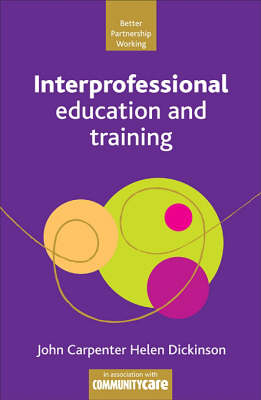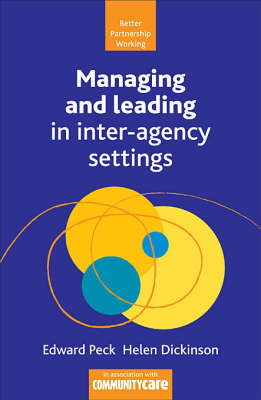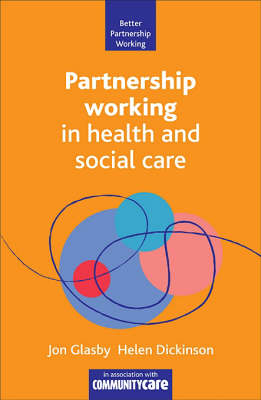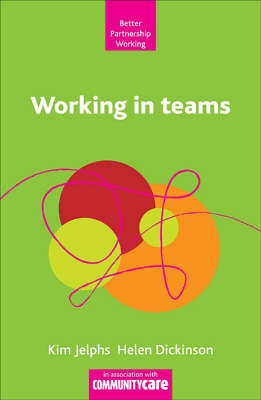Better Partnership Working
4 total works
As inter-agency working has grown increasingly important within UK public services, inter-professional education (IPE) has been perceived as a solution to a number of the practical difficulties associated with this way of working. Particularly, IPE is regarded as crucial within areas such as safe guarding children, community mental health services, older people's services and services for disabled children where the quality of care needs to be delivered by seamless multi-professional teams. Written by leading specialists in the field, this book provides a thorough introduction to IPE in health and social care, examining the issues in detail and providing much needed practical advice. The authors summarise recent trends in policy, establish what we can learn from research and practice and provides readers with an essential set of IPE 'do's and don'ts'. It will be a core text for undergraduate and post-qualifying interprofessional students on health and social care courses, as well a students of nursing, social work, social policy and medicine.
Managing and Leading in Inter-Agency Settings
by Helen Dickinson, Gemma Carey, and Edward Peck
Published 7 May 2008
Leadership and management are increasingly considered important drivers in terms of organisational performance. Yet, despite being viewed as essential components of partnership working, there is relatively little thoughtful work analysing the relationship between the two sets of ideas - posing practical difficulties for leaders and managers of partnerships who are looking for evidence or guidance. This book provides a robust guide to the leadership and management of partnerships. It summarises recent trends in policy, establishes what we can learn from research and practice and sets out useful frameworks and approaches to address a range of problems that partnerships face. It will be an essential aid to policy makers, managers and practitioners, providing a realistic account of the main characteristics and expectations of leadership and management in partnerships.
Partnership Working in Health and Social Care
by Jon Glasby and Helen Dickinson
Published 7 May 2008
UK health and social care are increasingly being asked to work together across traditional agency boundaries. Although this sounds easy in theory, doing it in practice is incredibly difficult and complicated. In many cases, moreover, current training programmes, research and textbooks are even more divided than front-line services, and practitioners and managers are often being tasked with making partnerships work without the necessary support. Against this background, this book provide a 'warts and all' introduction to partnership working, summarising current policy and research, setting out useful frameworks and approaches, and helping policy makers and practitioners to work more effectively together.Short, accessible and practical, the book is aimed at students, practitioners, managers and policy makers in health and social care. Written by a leading team from the Health Services Management Centre, the book is also fully evidence- and research-based, whilst still being accessible and applicable to everyday practice. The first in a broader series on "Better Partnership Working", this is the one book that everyone wanting to work in health and social care should read.
This exciting series of accessible 'how to' books provides an essential introduction to partnership working. Designed to be short and easy to use, the books offer practical support to those working in partnership and provide helpful frameworks to make sense of the complexity which partnership working entails. Summarising current policy and research in a detailed but accessible manner, each book provides practical, evidence-based recommendations invaluable for policy and practice.
This exciting series of accessible 'how to' books provides an essential introduction to partnership working. Designed to be short and easy to use, the books offer practical support to those working in partnership and provide helpful frameworks to make sense of the complexity which partnership working entails. Summarising current policy and research in a detailed but accessible manner, each book provides practical, evidence-based recommendations invaluable for policy and practice.
Working in Teams
by Kim Jelphs, Helen Dickinson, Robin Miller, and Lynn Markiewicz
Published 7 May 2008
Teamworking is represented as playing a central role in the improvement of health and social care. However, it is mentioned so often, with so many different promises, that there is danger of it being seen as misguided rhetoric rather than practical reality. Although, in theory, working in teams sounds easy, doing it in practice within the complex systems today's practitioners are faced with is incredibly difficult, complicated and often frustrating. This accessible text introduces a range of theories, models and research to demonstrate the benefits - and pitfalls - inherent in teamworking. In addition, it provides frameworks and practical advice on how inter-agency teams may be made to function more effectively. Illustrated throughout by real examples from practice, this no-nonsense book will be ideal for students, practitioners, team leaders, managers and policy makers in health and social care.



